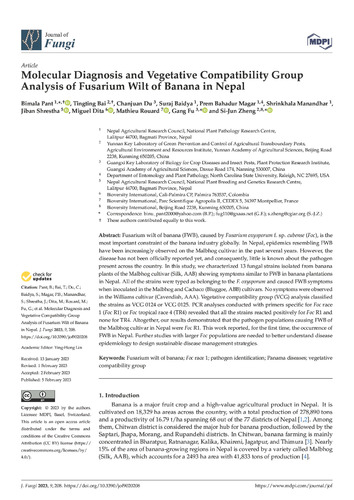Molecular diagnosis and vegetative compatibility group analysis of Fusarium Wilt of banana in Nepal
Abstract
Fusarium wilt of banana (FWB), caused by Fusarium oxysporum f. sp. cubense (Foc), is the most important constraint of the banana industry globally. In Nepal, epidemics resembling FWB have been increasingly observed on the Malbhog cultivar in the past several years. However, the disease has not been officially reported yet, and consequently, little is known about the pathogen present across the country. In this study, we characterized 13 fungal strains isolated from banana plants of the Malbhog cultivar (Silk, AAB) showing symptoms similar to FWB in banana plantations in Nepal. All of the strains were typed as belonging to the F. oxysporum and caused FWB symptoms when inoculated in the Malbhog and Cachaco (Bluggoe, ABB) cultivars. No symptoms were observed in the Williams cultivar (Cavendish, AAA). Vegetative compatibility group (VCG) analysis classified the strains as VCG 0124 or VCG 0125. PCR analyses conducted with primers specific for Foc race 1 (Foc R1) or Foc tropical race 4 (TR4) revealed that all the strains reacted positively for Foc R1 and none for TR4. Altogether, our results demonstrated that the pathogen populations causing FWB of the Malbhog cultivar in Nepal were Foc R1. This work reported, for the first time, the occurrence of FWB in Nepal. Further studies with larger Foc populations are needed to better understand disease epidemiology to design sustainable disease management strategies.

